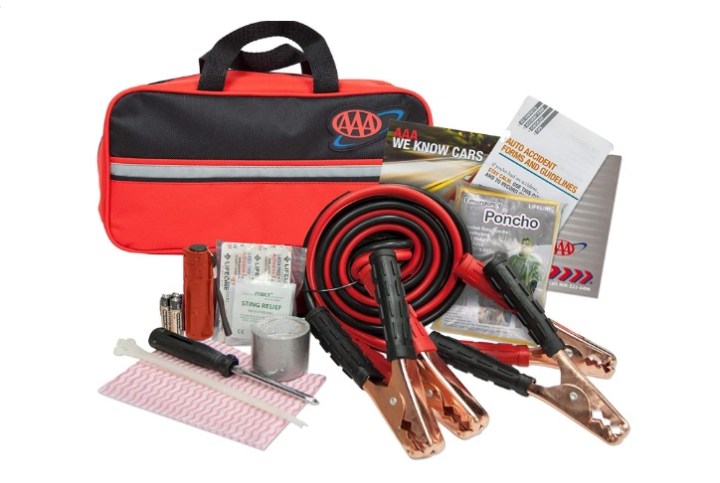Although new and late-model cars are generally reliable, there’s no guarantee that they won’t break down at the worst possible time. And, sometimes it’s not a mechanical issue that stops your trip; it’s an accident, a flat tire, or the weather. That’s why keeping an emergency kit in your trunk is crucial, especially if you’re taking a long drive.
Here are some of the items we’d pack before trekking across the country.
Further reading
Primary emergency kit items
Flashlight (with extra batteries)

One of the most important items to pack in an emergency kit is a flashlight. Whether you’re changing a tire on the side of the road or simply trying to flag down help, a little bit of light can go a long way. Pack extra batteries, too, in case the ones in your flashlight have been drained. And, keep it close, like in the glovebox, rather than in the trunk.
Reflectors

One of the most dangerous aspects of being stuck on the side of a highway is the risk of a collision with a passing vehicle. Placing at least one reflector several yards behind your vehicle will warn other drivers and create a buffer between you and oncoming traffic. Reflects are often triangle-shaped, like the one shown above.
First-aid kit

Having a first-aid kit at your disposal is crucial if you’re involved in a minor accident. Whether it’s a fender-bender with another car or a misstep while hiking, it’s wise to carry bandages, antiseptics, and pain relievers.
Fire extinguisher

It’s a good idea to have a fire extinguisher within reach when you’re dealing with combustibles, like gasoline. After a car crash, a small fire (which isn’t unheard of) can escalate into a much bigger problem in a matter of minutes.
Jumper cables

Out of all the items you can pack in an emergency kit, jumper cables and a flashlight will be the tools you use most often. After all, humans can be scatterbrained at times, and we will inevitably leave a dome light on or forget to turn off the parking lights. Dealing with a dead battery is less of a headache when you’ve got jumper cables in the trunk.
Ponchos

Breaking down is bad enough, but having to change a tire on the side of the road in the middle of a rain storm is even more frustrating. While a basic poncho won’t save your life during an emergency, it will make your life a lot easier if you need to walk in the pouring rain to find help, or if you need to spend 10 minutes with your head under the hood.
Tow straps

Getting stuck isn’t the same thing as breaking down, but the end result is the same: you’re no longer moving. When driving through wintry conditions, it’s important to carry a tow strap or two in case you get stuck. It will make pulling you out of a rut, or off of a snow bank, a lot easier for the charitable soul that stops and help you.
Essential car emergency gadgets
Stinger USB Emergency Tool

The Stinger Emergency Tool is something to have at your disposal when things go awry. After a major accident, car doors and seat belts may be jammed. The Stinger packs a powerful punch to shatter windows, allowing you to get out, and its backside incorporates a blade to cut through a malfunctioning seatbelt. It doubles as a USB charger.
Portable jump-starter

Jumper cables are great if there are other cars nearby to give you a friendly jolt, but they’re useless if you’re stuck in the middle of nowhere. This is when a self-powered jumper cable kit is priceless. The better models on the market (like DBPower’s jump-starter) can also charge devices like laptops and phones.
Emergency Beacons

Reflectors tell oncoming vehicles that your car is broken down on the side of the road, but inclement weather greatly reduces visibility. We suggest using emergency beacons in these circumstances to ensure you’re seen.
All-in-one options

Several companies offer all-in-one roadside emergency kits that feature most — and, sometimes, all — of the items listed above. Pricing ranges from $20 for a basic kit to over $100 for something more advanced. AAA sells a $25 kit that includes a flashlight with batteries, jumper cables, duct tape, a screwdriver with two tips, and a poncho, among other items, plus a handy bag to stuff it all in so these items don’t roll around in your trunk.
Other items to consider
Even though a good emergency kit will cover the basics for you, it’s not a bad idea to supplement with other useful items such as oil, coolant, and windshield wiper fluid. Older vehicles tend to burn through oil and overheat more quickly, so those first two items are a necessity. You can never have too many rags, either. These items always end up providing that extra juice during an emergency situation that helps get you those last few miles to a mechanic or gas station.
Don’t forget to seasonally update your kit. Weather crises like snowstorms can hit suddenly, so it’s a good idea to stow non-perishable food and water bottles in the winter. Bring extra blankets and hand warmers if you plan to drive through a rural area and a set of tools if you know how to use them. You don’t want to get caught with a dying engine in a snowbank.
This tip may be the weirdest on the list, but keep cat litter in your car during the winter. Cat litter has excellent adsorbent properties. If your car loses traction on snow or ice, scatter some cat litter around the wheels to help get moving. Salt or sand also works, but surprisingly not antifreeze.



